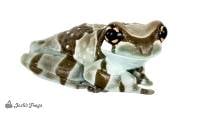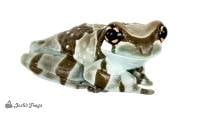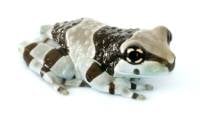Josh's Frogs
Amazon Milk Frogs (Captive Bred)
Amazon Milk Frogs
Scientific Name: Trachyephalus resinifictrix AKA: Phyrnohyas resinifictrix
Common Name: Amazon Milk Frog
Distribution: Amazon Basin
Size at Maturity: 3 - 3.5 inches
Trade Availability: Scarce, Captive Bred/Born
Natural Habitat: Tree dweller often found on the bark of trees
CAPTIVE HABITAT:
- A 29 gallon aquarium or 18x18x24 terrarium is suitable for 2 - 3 adults. A large enclosure is required because of their size.
- The bottom of the terrarium should be covered with Peat Sphagnum (1/4 inch).
- Shallow water dish (distilled water is recommended)
- Plant consisting of Pothos, Ficus and Philodendron.
- It seems they enjoy branches hanging over water.
TEMPERATURE (°F):
- Daytime: No more than 82 degrees
- Nighttime: 68–70°
- Monitor temperature with a reliable thermometer
HUMIDITY:
Suggestion for the cover/lid is screen top covering 80% with Saran Wrap, glass or plexiglass.
Monitor humidity with a reliable hygrometer.
LIGHTING:
2% UVB is required for froglets 2 months & older, no more than 3% UVB. UVB is essential for frog’s growth.
**UV rays help eliminate excess bacteria growth (not to say bacteria will not grow in the tank, but it will help lower it).
FOOD:
Small froglets can be offered 1/8 inch crickets
As juveniles – 1/4” crickets - Try house flies for an entertaining treat!
Adults can be upgraded to 1/2–3/4 inch crickets.
**Adults may be offered small roaches of the same size as the crickets they're currently eating.
Dust all food with Rep-Cal Herptivite & Rep-Cal Ultra-fine Calcium w/Vitamin D3
***3 parts Herptivite to 1 part Calcium***
Breeding:
They are not exceptionally difficult to breed, but can be difficult to breed consistently. Seasonal cycling, coupled with a large water volume and heavy feeding, can encourage breeding. Each female will lay between 300-1,000 eggs, which quickly develop into voracious tadpoles that eat A LOT! After about 2 months in the water, the tadpoles morph into dime-to-penny-size froglets, which are initially gray in color.
Links of Interest:
- Amphibian Care – Good Amazon Milk Frog Care sheet by Devin Edmonds, a very accomplished frog hobbyist and researcher
- Amazon Milk Frogs from Josh's Frogs




